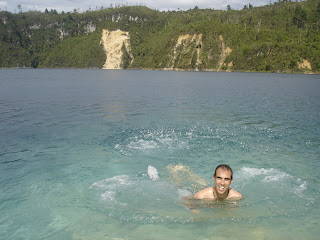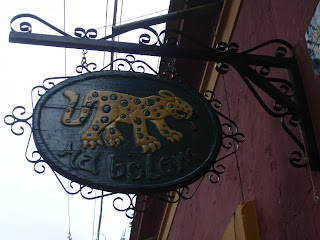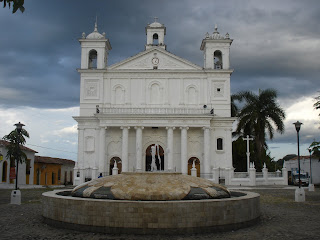
One of our tours took us to the nearby Tsotsil communities of San Juan Chamula and Zinacantan. It was during this tour that we got to meet Erika (the girl from Mexico City who we had dinner with that evening), a married couple from near to Mexico City, Claudia and Enrique, and two English people, Matthew and Elena. The whole group got on really well, talking lots and sharing their travel experiences. It makes such a difference when you get chatting to the other people on your tour, and this was by far the most friendly of the three groups we found ourselves in.
Our first stop was San Juan Chamula, only a 20 minute drive from San Cristóbal. The first thing our driver said to us was that we could only take photos when he told us it was fine to do so. The people of this community believe that if you take a photo of them, the camera steals their soul, so obviously you have to be very careful about where you point your camera :) We were able to take panoramic shots only and we had to be standing a good distance away from any of the locals. (I managed to get a sneaky one of some women on a bench with plenty of zoom...Vic has uploaded it in his post below).

Some of the younger people will let you photograph them but only if you give them money, and otherwise, if someone suspects that you have taken a photo of them they will demand to see your camera and in the best case will simply get you to delete it, but apparently there have been cases where people´s cameras have been destroyed, which is obviously a complete disaster for any traveller. Luckily we didn´t have any issues while we were there :) And while we´re on the subject of photo-taking, it is completely forbidden to take any photos inside the church, as this is considered as stealing the soul of God. They don´t even like you to have your camera out while you are in there and it is such a shame, because the sight inside the church is unbelievable....completely different to anything I have ever seen before, but rules are rules :) (Actually, at a museum later that day, I saw a photo of the inside of this church, so all I´ve got is a photo of a photo meaning that it´s not very clear, but I hope you can get the idea).
So the church...there are no pews, nor chairs. Everyone sits in groups on the floor, which is covered with grass, as contact with the Earth purifies both the church and the people who walk upon it. The people are Christians but they don´t have priests and neither do they hold mass. The rituals they perform are specific to each family group and include a healer, several burning candles of different sizes and colours, live hens, eggs, fizzy drinks and a good deal of chanting. I told you it was different :) The healer sits in the centre of the group and feeling for the pulse of each member of the group and 'listening' to their blood, he can determine what they should pray for. The candles represent each of their prayers, ranging from small to big, depending on how important the prayer is.

(I´m not sure what the different colours represent). When we were there I think there must have been about 1,000 candles alight, the amount of smoke and the smell was incredible. As for the hens and the eggs, these get passed from person to person, but again I´m not sure of the significance. Finally, the fizzy drinks are for drinking towards the end of the ritual...the gassy sensation makes them feel like they are being 'cured' or 'cleansed within'. The first fizzy drink to arrive in San Juan Chamula was obviously Coca Cola, which they used to consider as sacred, but with the arrival of Sprite and Fanta etc. and realising that these had the exact same effect, Coca Cola ceased to be sacred and now any old fizzy drink will do. Coca Cola seems to still be the preferred favourite though :) Before Coca Cola, they used a herb, which made them vomit upon eating it. With the introduction of Coca Cola, they found a similar effect without having to vomit, which is obviously a lot more pleasant, and it tastes better too!
Apart from the church, our guide told us several other interesting facts about this community of 60,000 people. Firstly, they are very protective of themselves and do not like the intrusion of foreigners (which makes me think why do they allow tourist groups to visit them?, but anyway...). Hence there are no hotels or any kind of accommodation for visitors, limiting them only to a visit of an hour or so with a guide. I think you could go there of your own accord, but most of the guide books recommend going with someone with a knowledge of the community, as you can get into all sorts of trouble if you do something that the locals don´t like (i.e. take a photo of them). As a result of not wanting to mix with others, they marry among themselves and although there is a fair-sized population of 60,000 people there are only 10 or so different surnames!! The town is kept in check by the 'authorities' who are changed each year on the 1st January (the new authorities are chosen by the previous ones, and they are usually thought to be the people with the highest education within the community). They wear hats with coloured bits hanging off them and walk around with truncheons. The community is subject to its own set of laws, kept in force by the authorities. No-one is allowed to follow a different religion or vote for any political party other than the PRI, who generously donate money to the community (talk about buying votes!). If anyone goes against this way of thinking, they are expelled from the community. Vic asked our guide if anyone has ever questioned this complete disregard for man´s liberty, to which our guide replied that if this ever does happen, that person will also be expelled from the community. This got us to wondering if all the Tsotsiles living in San Cristóbal are people that have been expelled from Chamula. Who knows?

The men are the rulers of the community and the women have no say whatsoever. Fathers still arrange their daughters' marriages, selling them to their prospective husbands for an agreed fee. If on the wedding night, the husband should find that his new bride is not a virgin, he can return the girl to her father and get his money back, and even fine the family for the disgrace. Girls are married as young as 11 and 12, and they start having families around this age as well, having anywhere between 6 and 15 children. As soon as they can walk, their parents give them something heavy to wear on their backs, increasing the weight as they get older, so that they grow accustomed to working while carrying a baby. I was completely shocked by all of it, but this is the way of life for the women of this community, and it doesn´t seem that it will change anytime soon.
One last interesting thing that we found out, is that sheep are sacred animals for these people, and as such, they never eat lamb and do not rear them for anything other than their wool, from which they make items of clothing. Women traditionally wear skirts made of black wool and the men wear whole outfits made of white wool. Their sheep tend to live for about 15 years, and when they die (naturally of course), they hold a funeral and bury them like they would a member of the family.

After spending some time wandering around the market outside the church, we got back in the minibus to drive the few kilometres to Zinacantan, where we visited the home of a family who make their living from handicrafts. I say a family, but there were only women there, so I don´t know what the men do all day. When we first arrived we were shown all of the different products that they make including clothes, shawls, bags and table runners. They also gave us a short demonstration of how they make a scarf. After that they brought out some traditional wedding clothes and started dressing members of our group. First Elena was dressed up as the bride and then Vic volunteered to be the groom. I ended up as the mother of the groom I think, and I assume Enrique must have been the father of the bride. While in 'costume' we were treated to a taste of three different flavours of pox (pronounced posh), which is an alcoholic drink, similar to tequila, made from corn and sugar. The flavours were jamaica, which is difficult to describe, cinnamon and natural. The natural was the strongest of them all and my favourite was the jamaica. It was lots of fun getting dressed up and we took several photos, one of which Vic has uploaded below. No mocking comments please :)
Before heading back we got to taste some of their home-cooking. We had quesadillas filled with cuajada (a kind of soft cheese) and tortillas which we filled ourselves from a selection of avocado, tomato, more cuajada, beans and a few different salsas. It was all delicious and it was good to be able to watch them prepare it all. They cooked over a wood fire and they had a wooden contraption with which to flatten out the tortillas....in Tortuga, Nicaragua, we had to shape the tortillas with our hands :)

We didn´t see anything else of Zinacantan but the experience we did have was more than enough for us. In front of the house we visited we noticed a huge hill with a building on top, which our guide told us was the church. Curious as to how long it would take to walk up to, he told us that the people say that it takes about an hour, with the help of God of course :) We had a really fantastic day, and it was definitely the most interesting and eye-opening of the tours that we went on from San Cristóbal, although another favourite of mine was the Sumidero Canyon, but more about that in my next post.
 15/09/09-16/09/09
15/09/09-16/09/09 After all the shouting, there was lots of cheering and clapping, followed by a rendition of the national anthem and an amazing, albeit brief, firework display. The atmosphere was buzzing...it was so great to be a part of it! The army also play a big part in the proceedings, raising the flag of the town hall to full mast and providing musical interludes, and this year was particularly special, as it was the first time in fifteen years that the army has been able to join in the celebration. Until now, and ever since the Zapatista Revolution in 1994, the army have been unable to enter the state of Chiapas...we're yet to find out why!
After all the shouting, there was lots of cheering and clapping, followed by a rendition of the national anthem and an amazing, albeit brief, firework display. The atmosphere was buzzing...it was so great to be a part of it! The army also play a big part in the proceedings, raising the flag of the town hall to full mast and providing musical interludes, and this year was particularly special, as it was the first time in fifteen years that the army has been able to join in the celebration. Until now, and ever since the Zapatista Revolution in 1994, the army have been unable to enter the state of Chiapas...we're yet to find out why! The next day, celebrations continued with a military-civic parade around the centre of town. We watched for an hour as armed soldiers marched by on foot, and others passed by in army trucks or tanks equipped with huge guns. Following the soldiers were groups of students from the various educational institutions of San Cristóbal: school children in uniform, trainee chefs and nurses, also in uniform, they all took part, and luckily I had a good view for a change, as I managed to get up a bit higher than the majority of the crowd so I was snapping away for the duration and I also got a few videos too. I haven't checked them yet, but if there is a good one, I will upload it soon. I have a great one of the Cry of Independence, which I will definitely put on here as soon as I can!
The next day, celebrations continued with a military-civic parade around the centre of town. We watched for an hour as armed soldiers marched by on foot, and others passed by in army trucks or tanks equipped with huge guns. Following the soldiers were groups of students from the various educational institutions of San Cristóbal: school children in uniform, trainee chefs and nurses, also in uniform, they all took part, and luckily I had a good view for a change, as I managed to get up a bit higher than the majority of the crowd so I was snapping away for the duration and I also got a few videos too. I haven't checked them yet, but if there is a good one, I will upload it soon. I have a great one of the Cry of Independence, which I will definitely put on here as soon as I can! Sadly, our time in this wonderful city has finally come to an end, and we will be heading next to Palenque, where we will see the first of many Maya ruins. How exciting :)
Sadly, our time in this wonderful city has finally come to an end, and we will be heading next to Palenque, where we will see the first of many Maya ruins. How exciting :)

















































